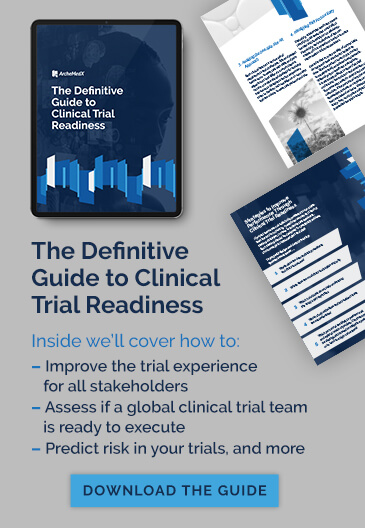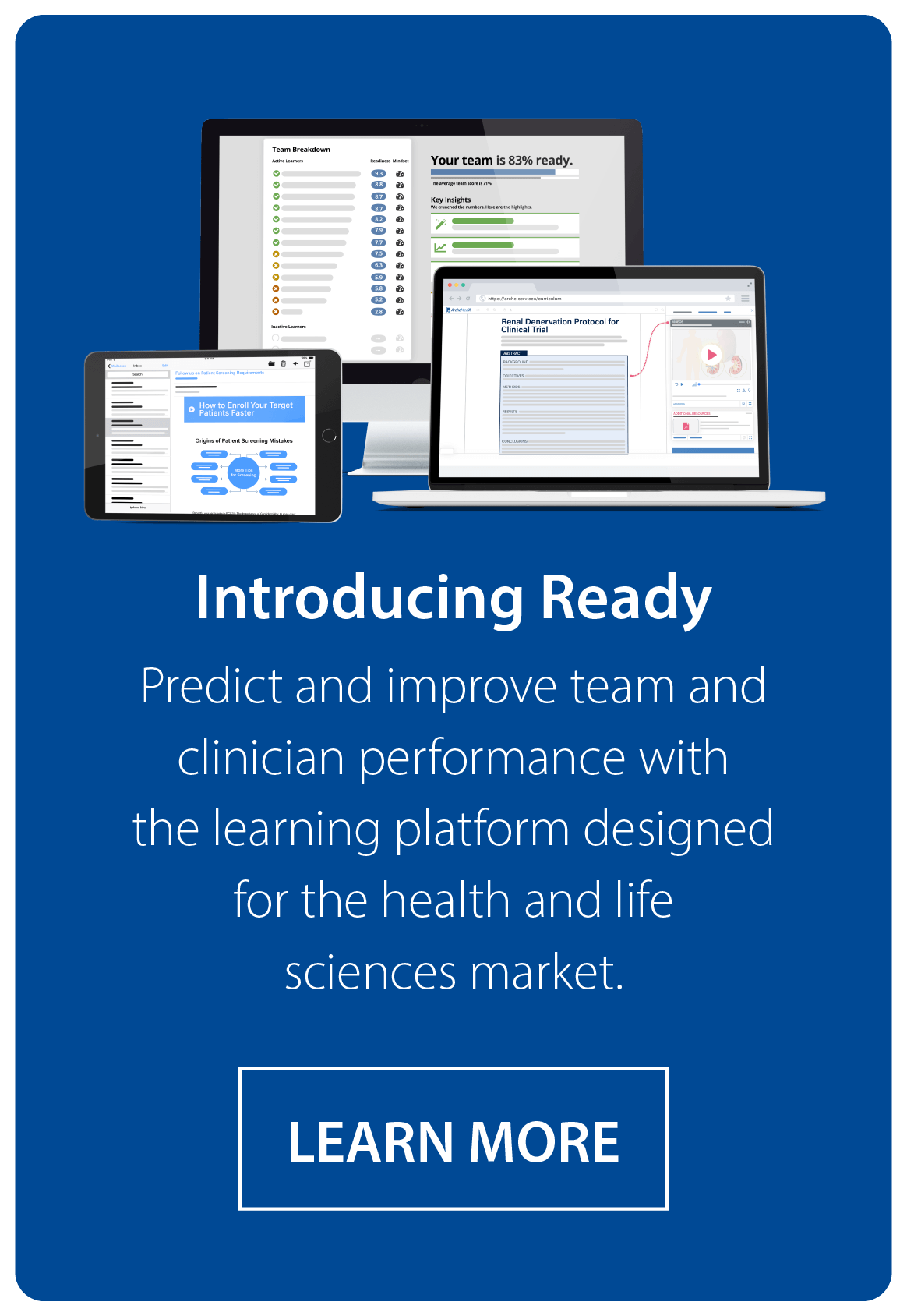Choosing the right way to train clinical trial staff is complex and exhausting under normal circumstances. Today’s immense pressure to accommodate new virtual working styles across investigator meetings, site selection, and site initiation visits magnifies those challenges.
As we revealed in our recent report, clinical operations leaders are adopting virtual tools everywhere they can so they can more quickly restart clinical studies. And in our recent report, COVID-19’s Impact on Clinical Operations, we discovered that the industry has a few major focus points for study start-up:
- To virtualize everything possible
- To better understand clinical trial site readiness
- To specifically transition site selection, investigator meetings, and site initiation visits to virtual models
Want the checklist in printable form? Download it here.
Choosing a solution to equip and train clinical trial site staff? Here’s what you’ll find on this checklist.
But now you need the technology to do just that – so check out this detailed checklist to help ease your load in the selection process. What you’ll find in this article:Why choosing the right solution matters for your clinical trials
Outlining the outcomes your clinical trial solution must deliver
Defining the learning objectives for your trial sites
Factors You Need to Consider in Choosing a Platform
Must Have Features for Clinical Trials
Understanding Pricing
Why choosing the right solution matters for your clinical trials
We know that the majority of the industry is planning to virtualize the clinical trial start-up stage. The reality is that trial start-up activities are primed for virtual delivery. Most of them will scale better, perform better, and deliver better actionable data for decision makers in a virtual model. And if you virtualize these activities successfully, then you will be able to gain efficiencies, ensure continuity of messaging, and greatly reduce many of the start-up delays you commonly encounter. But when it comes to selecting a learning platform, you have to remember that it will impact these three things:- How quickly you can select the right trial sites.
- How quickly you can verify they’re prepared to enroll subjects.
- How quickly you can actually start enrolling patients.
1. Outline the Outcomes Your Clinical Trial Training Solution Must Deliver
The best solution for equipping your trial sites is the one that successfully delivers the outcomes and objectives that you need to make better decisions about site start-up. These outcomes must go far beyond being able to upload a protocol, add additional resources or files, and distribute the content quickly on-demand. More importantly, think about the real business objectives you have for your trial staff and focus on the outcomes required to more effectively conduct the study. Some examples include:- Move beyond simply identifying who has completed your site training, and who has not. Insead, measure how well individuals and site teams demonstrated comprehension of the protocol and processes.
- Evaluate individual confidence in making the right decisions.
- Reveal the sites and teams that are best-equipped for starting your trial now.
- Uncover sites and teams that may not be prepared – but could quickly become ready with additional support and remediation.
2. Define the Learning Objectives for Your Trial Sites
In addition to your desired outcomes, you need a clear list of which procedures your team and site staff should be capable of performing at the end of your training curriculum. Your objective for your team may be to identify which sites are best prepared. Meanwhile, your objective for sites could be that they are prepared to succeed with the trial protocol. Some ideas on what to include in your learning objectives:- Site staff must demonstrate they fully understand the protocol and enrollment criteria.
- Site staff need to demonstrate confidence in making decisions about patient eligibility.
- Site staff need to prove that they can make the right decisions after the training.
3. Factors You Need to Consider in Choosing a Platform to Train Clinical Trial Site Staff
Now that you’ve established your objectives, there are other factors that you need to consider — before you get to features and functionality.Industry focus
Despite the fact that there are many tools available that can deliver content, they’re not all up for the challenge of serving a clinical trial team. There are many nuances that you need a partner to understand, including the global nature of sites, the complex nature of the content itself, and your specific business needs. Ideally, choose a tool from a company with deep experience in clinical operations that can provide use cases and references in your industry.Delivery
Is the training platform an on-premise solution that you have to host somewhere, or a fully SaaS enabled model? Is it available on-demand for site staff at any time, or is it a live-only solution? Does it offer automated engagement tools to re-engage site staff over time? Be sure you understand how both the learning platform and content are delivered to your learners so you don’t select a “live only” meeting tool when what you really needed was something that offered “on-demand” training for a global trial.Support
When things go wrong, and something always does, be sure you understand the vendor’s support model. Be sure you know who to contact for what – and pay attention to how forthcoming the vendor is during the early stages of your relationship. Also, will you be responsible for updates and patches, or is the tool a true SaaS product that includes all technical support? Be sure you know what is your – vs. the vendor’s – responsibility.Scalability
Many tools can provide training for a few hundred users in a single location, but you may need something more scalable. Make sure that you understand the ability for any training tool to cross borders, and support a global trial — if only for the future.4. Must Have Features for Anything You Use to Train Clinical Trial Site Staff
Every learning platform has their own set of unique features and functions. But in order to successfully prepare your clinical trial site staff, you need to make sure the platform you select has these following features.Flexible content support
Content is the foundation of your clinical trial team’s success, and thus of your training. Any other feature succeeds only if your content is consumed. You need to be sure you understand that the platform will support everything that you need to guarantee a fully comprehensive site training! Make sure you ask these questions:- Can I upload my protocol directly, or do all trainings have to be delivered as video?
- What content types are supported (like PDF, image files, audio files, etc.)?
- Am I limited in the content size or number of files?
- How easily can we add new content?
- How easily can we update existing content?
- Can I reuse content across trainings?
Annotated learning
Besides the base content itself, you need to understand how you can enhance the site staff’s learning experience to point them to specific key objectives in the protocol. This ensures that new or unique requirements of the protocol or processes aren’t missed and that site staff focus on your key study objectives. Annotated learning is a critical part of training your sites well, so make sure you require this on your checklist, along with some clarifying questions like:- How easy is it to annotate a piece of content?
- Can I link my annotations to specific study objectives?
- What types of annotations can I use (like including an additional resource, a quiz, or an immersive multimedia file)?
- Can I control how the annotation is presented based on its relevance?
- How do I measure and evaluate how a staff member interacts with the annotations?
User behavior tracking
When we start to consider the types of reporting you need for your objectives, it’s wise to start with the basics. User tracking data is great for monitoring as a clinical operations leader. It lets you gauge the learning tendency of the site staff. It also helps you check the amount of time they spend on a particular lesson or the number of attempts made for passing any assessments.Assessment
You absolutely must ensure you will receive the right insights on the performance of the site staff from your tool. Many training platforms are designed for very general use – where completion is straightforward. Often, in these tools assessments are limited to multiple choice. But for the demands of a clinical operations team, you need more. Remember that your main objective is to train the site staff so you can select and initiate the most ready sites. So ensure that your training platform offers more than just a “quiz” to validate their readiness. Add these questions to your checklist:- What types of assessments can we use in gauging trial site staff knowledge?
- Do you offer confidence based assessment as a standard feature?
- How can we design and adapt assessments to meet different training objectives?
- Can we allow team members to “test out” if they’ve previously proven their knowledge?
- If test out is allowed, how much control do you have in setting the right thresholds?
- What metrics do you incorporate in assessing site staff, and can we configure some of them?
Readiness scoring
The training platform’s approach to enabling clinical trial site readiness comes last, but it’s the most important for your purposes. Ensuring that individuals and sites are sufficiently prepared (i.e., ready) to conduct your clinical studies is an essential part of keeping the many people who participate in clinical trials safe while ensuring the trial runs smoothly, remains in compliance, and stays within budget. The key to improving trial outcomes is having training strategies in place to improve trial readiness by effectively assessing and rapidly identifying those individuals and sites that will be high performers and those that may require additional training and support. So, make sure that your training solution is equipped to help you employ this critical part of assessing trial sites and team members. Ask your vendors how you can uncover these details about sites:- Which sites are demonstrating readiness and likely to succeed
- Which sites are most likely to struggle and why
- Which individuals do not fully understand the study’s key objectives
- Which study objectives and key subject areas are misunderstood
- Which personnel are likely to perform well and against which objectives. Can these people be strategically placed to mitigate a point of risk, or to tend to a high-value item?
5. Understanding Pricing
Your budget is always a major consideration, and every software product out there seems to have a different pricing model. The pricing model for a training solution may vary from vendor to vendor. Make sure you understand the entire cost of the project, as well as when fees might come into play. Because there are so many pricing models, it’s very difficult to compare vendors on price alone. So instead, make sure you ask these budget questions to get the full pricing picture:- How is the product licensed? Per user, per site, per learning activity, one-time cost?
- Are there hosting/support costs in addition to the license?
- Are there additional annual costs associated with the software?
- Are there implementation costs, like installation or setup fees?
- Are there additional costs to activate new sites or add new staff?
- Is there a threshold on content or on the number of trainings?
- Will we need to purchase additional hardware or software to make the training platform work?




